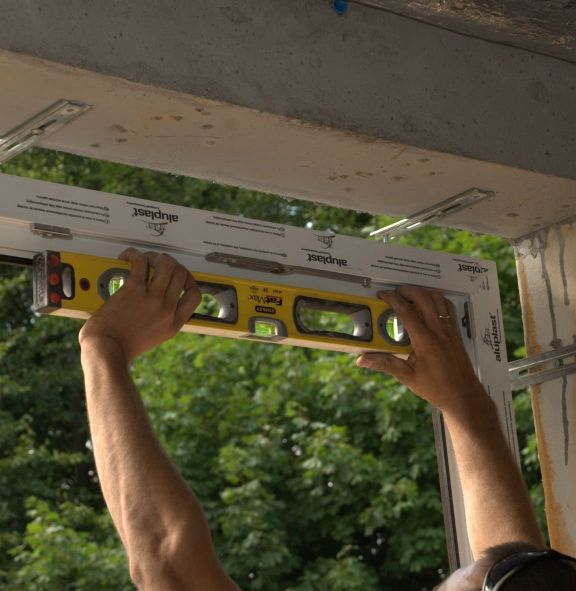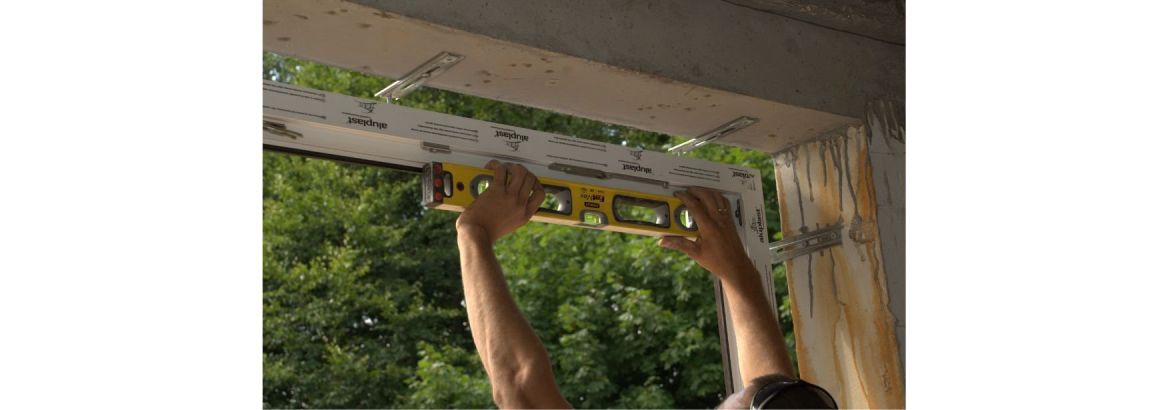One of the most important problems when it comes to designing passive houses is making the building as airtight as possible and eliminating thermal bridges. Therefore, reducing heat loss as much as possible is key. For this reason, windows are so important in passive houses. Windows are a crucial element of the airtight construction of the whole building, but their divisions tend to have the worst heat insulation coefficient value. Their role is to reduce heat loss, while passively using solar energy to warm up the rooms and make them brighter.
Making sure that the architectural mass is compact and that the windows are properly placed in order to maximize the usage of solar energy – those are important decisions when designing a passive house. Proper placement of windows, their size and type can majorly decrease the demand for energy needed to heat the rooms. Especially the size of the windows and their divisions can influence the value of heat transfer coefficient. The general rule is that the less space the frame of a window takes, the lower the heat transfer coefficient is. Every additional division made in a window makes the surface of the glass smaller, while creating more thermal bridges on the junction of the glass and the frame. Large glass windows with a thin frame are often chosen for the passive houses, because of the energy. However, it is important to note that some materials cannot be made into large windows.
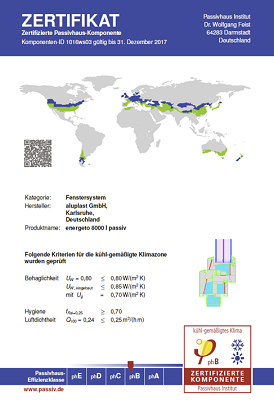
The windows are the most responsible for heat loss in a passive building, while gaining the most solar energy at the same time. Therefore, it is the selection of windows and calculations of energy performance for windows are especially important. When choosing windows for a passive house you should remember that the construction of a passive building is not only important for the aesthetic value but it can also influence the value of heat transfer coefficient of windows. It is a common mistake to include only the coefficient of the glass – Ug – when setting the heat parameters of windows. It is true that the glazing and its heat insulation is the key factor, however, the Uw coefficient should also be included. By installing very warm glass panels we can easily decrease the value of the heat transfer coefficient, but it is not an optimal solution when the frame’s parameter are much weaker. This is why the Passive House Institute in Darmstadt gives certificates only to windows that have the heat transfer coefficient Uw ≤ 0.8 W/m2K and Ug = 0.7 W/m2K for the glazing. In order to achieve such strict values for the windows, it is important to use high class profiles with the heat transfer coefficient value Uf = 0.8 W/m2K. Only windows that meet all those criteria can be certified by the Passive House Institute in Darmstadt.
The window puzzle
Knowing that windows that are made of the same components, can have different sizes, divisions and heat insulation, we should choose profiles and glass panels that together have the set heat transfer coefficient and solar energy emission. Those parameters are often individually selected for windows that are to be placed on different parts of the elevation. Therefore, you should be aware of how different components determine the value of Uw coefficient and try to optimally balance them out.
The main parameter that characterizes heat properties of a window is the heat transfer coefficient Uw. The U coefficient is described in W/m2K units and it defines how much heat transfers through 1 m2 of a flat division (e. g. window, wall) in 1 hour when the difference of the air temperature on the inside and on the outside equals 1K (1 °C). In the graph down below we presented the formula for calculating the heat transfer coefficient of a window – Uw – as well as all the components and an example, using a 1230x1480 mm window.
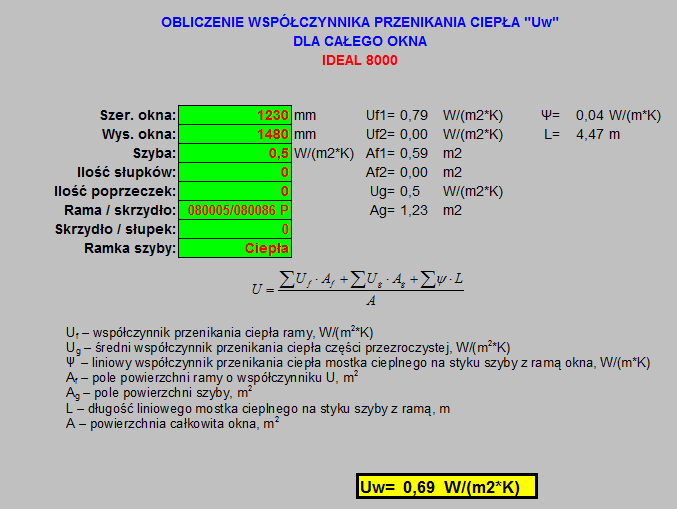
Achieving the set value of thermal insulation for passive houses – Uw ≤ 0.8 W/m2K – is possible only when the profile and glazing were properly selected and when the coefficient for the thermal bridge on the junction of the glass and the frame is reduced.
The frames – how to reduce the heat loss
As far as PVC windows manufacturers are concerned, they often improved the thermal insulation of windows by: increasing the depth of the profiles and the number of chambers in the profiles, using special covers, and filling the chambers with thermal insulation materials. However, improving the heat properties using these methods is limited, therefore for many years the manufacturers have been focusing on the technology of constructing the windows, including eliminating steel reinforcements, which can negatively influence the thermal insulation, implementing the glass installation technology, using composite materials etc.
_1.jpg) Large chamber PVC profile filled with covers and polyurethane foam
Large chamber PVC profile filled with covers and polyurethane foam
_1.jpg) PVC profile, in which the steel reinforcements were switched for composite material with a glass fiber additive and the chambers were filled with a thermal insulation material.
PVC profile, in which the steel reinforcements were switched for composite material with a glass fiber additive and the chambers were filled with a thermal insulation material.
Glass, heat protection and free source of energy
Another important aspect of the thermal insulation of a window is glass, whose surface is most of the times bigger than the frame. Compared to standard widows, which have the heat transfer coefficient Ug = 1.1 W/m2K, the passive windows have glass panels with coefficient Ug = 0.6 W/m2K or Ug = 0.5 W/m2K. Often times they have triple pane glass with special low emissivity coating and space between layers of glass filled with noble gas. Low emissivity coating is a thin translucent layer that cover the glass, preventing it from losing heat, while selectively using solar energy.
The extent to which glazing can affect a home's heat balance and living comfort is determined by several parameters. The most important are: the heat transfer coefficient Ug, the total solar energy transmittance coefficient g (also described as the solar factor) and the light transfer coefficient Lt. The total solar energy transmittance coefficient tells us how much sun energy is transmitted through the glass to the room. We spend the most in our houses in the afternoon. In the summer, when the sun radiation is harsh and uncomfortable, we can fight it with blinds or other window covers. Apart from the summer, the sun energy can be used as a free source of heating energy. When setting the proper g coefficient for window glazing you should consider its size and its location in terms of directions of the world. It is especially important for big glass surfaces. In passive houses this parameter oscillate around 50-60%.
Another parameter that influences the comfort of living is the amount of light, that reaches the room. It is described by the Lt coefficient, whose value should be over 70%. The higher it is, the better, so that the room could gain more natural light. Light is not only crucial for living, but it is also free. The more natural light we get, the less artificial light we’ll have to use later.
An element that is sometimes overlooked in analyses, but which also has a significant impact on the thermal performance of the entire window structure and on limiting the value of linear thermal bridges at the interface between the glass and the profile, are spacers. In the case of joinery for passive houses, plastic-based frames are used, for which the values of the Psi coefficient are 0.03-0.04 W/(m*K). Replacing standard aluminum spacers with so-called "warm frames" can improve Uw heat transfer coefficient values by several percent.
Assembly crowns the work
A building element that, with the general improvement of window and wall insulation, is becoming increasingly significant and whose impact on heat loss from the building cannot be neglected is the window-to-wall connection.In passive houses, it is recommended to install windows in the insulation layer of a building to minimize the value of the thermal bridge that is created when the window touches the wall. Proper installment and airtightness where the profile meets the wall of a building is key to provide a satisfying insulation of the construction. When evaluating windows for a passive house it is necessary to take into consideration the calculation of the thermal bridge at the joint of casings. The heat transfer coefficient of a window built inside the insulation layer cannot be higher than 0,85 W/m2K.
_2.jpg) Example of certified passive window installation solution in the insulation layer, PHI Darmstadt (source Elwiz S.A.).
Example of certified passive window installation solution in the insulation layer, PHI Darmstadt (source Elwiz S.A.).
Although the number of passive buildings being constructed in our country is still negligible, more and more solutions are appearing in the offer of window joinery dedicated to this type of building. This increasing supply also reduces prices, which has a positive impact on the economic efficiency of this type of investment. Due to the large role that window joinery plays in passive buildings, it is necessary to carefully analyze all details related to both the selection of appropriate components and their proper combination.
Check out our products dedicated to passive buildings:
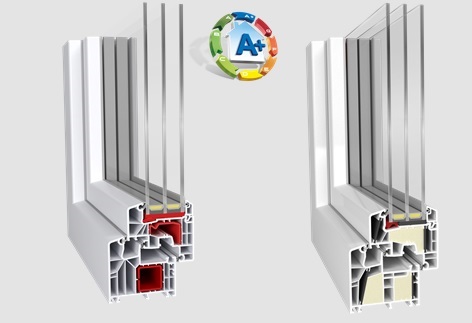
System okienny Ideal 8000 Systemy okienne energeto
We invite you to get acquainted with examples of interesting realizations in the field of passive construction, which were carried out using aluplast window systems:
